Bioconvection Cross Diffusion Effects on MHD Flow of Nanofluids over Three Different Geometries with Melting
Tahir Kamran,Muhammad Imran,Muhammad N.Naeem and Mohsan Raza
Department of Mathematics,Government College University Faisalabad,Faisalabad,38000,Pakistan
ABSTRACT Currently,nanofluid is a hot area of interest for researchers.The nanofluid with bioconvection phenomenon attracted the researchers owing to its numerous applications in the field of nanotechnology,microbiology,nuclear science,heat storage devices,biosensors,biotechnology,hydrogen bomb,engine of motors,cancer treatment,the atomic reactor,cooling of devices,and in many more.This article presents the bioconvection cross-diffusion effects on the magnetohydrodynamic flow of nanofluids on three different geometries(cone,wedge,and plate)with mixed convection.The temperature-dependent thermal conductivity,thermal diffusivity,and Arrhenius activation energy applications are considered on the fluid flow with melting phenomenon.The flow is analyzed under thermal and solutal Robin’s conditions.The problem is formulated in the mathematical formulation of partial differential equations(PDEs).The similarity transformations are applied to diminish the governing nonlinear coupled boundary value problems into higher-order non-linear ordinary differential equations(ODEs).The resulting expressions/equation numerically tackled utilizing the famous bvp4c package by MATLAB for various interesting parameters.The results were physically and numerically calculated through graphics and tables for the velocity field,energy distribution,nanoparticles concentration,and microorganisms profile for numerous parameters.From the obtained results,we discern that the transfer of heat and mass coefficient is high over a plate and cone in the flow,respectively.The velocity profile is reduced via a larger magnetic parameter.Temperaturedependent thermal conductivity enhances the thermal field.Larger thermophoresis enhanced the concentration of nanoparticles.The microorganisms’Biot number boosts the microorganism’s profile.
KEYWORDS MHD;nano-fluids;bioconvection;heat flux;MATLAB
Nomenclature

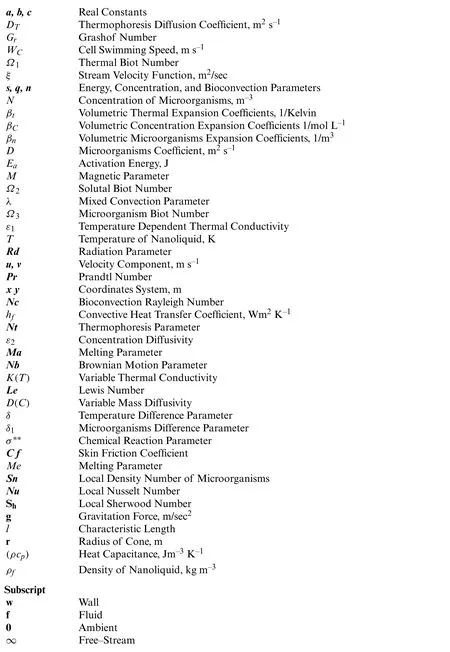
1 Introduction
Magnetohydrodynamics(MHD)has a vital role in several flow phenomena,including industry.The MHD is applied in various fields,including multidisciplinary technological areas like biochemical manufacturing heat transfer,automotive sector,ceramic technology,aerodynamic performance,metallurgical technology,mental operating techniques,and fluid dynamics.Magnetohydrodynamic initiation changes the flow field’s preferred direction by fluctuating boundary layer configuration flow.Electromagnetic fields play an important role in convection mechanisms like metallic casting,material processing fields,and nuclear reactor control plants.Zheng et al.[1]investigated the heat transformation in the two-dimensional flow of magnetohydrodynamic(MHD)by considering temperature and velocity slip effects through a shrinking porous surface.It was stated that the thermal boundary layer flow declined to owe to an increase in the shrinking parameters.The heat transmission and magnetohydrodynamic flow through the porous plate and shrinking surface were studied by Chauhan et al.[2].The central concept was that the cooling rate was controlled by the electromagnetic number and suction parameter over channels bounded.Attia[3]examined the different physiological properties of the unsteady MHD Couette flowing heat exchange in a dusty fluid flow with variable viscosity.Kumar et al.[4]explored mass and heat transport across a vertical plate under the cross-diffusion impact in radiative mixed convective cases of magnetohydrodynamic fluid flow.The fluid movement increased with an increase in both the buoyancy force variables and the mixed convection parameter.Ibrahim et al.[5–7]observed heat exchange and MHD boundary layer nanofluid flow via vertical surfaces and a non–isothermal expanding surface using the similarity transformation technique.Ibrahim et al.[8,9]described nanoparticles’MHD boundary layer flow through a stretched surface,influenced by double stratification and diffusion.Muhammad et al.[10]discussed the Eyring- Powell nanofluid with thermal radiation effects.Waqas et al.[11]checked the melting effects in a modified second-grade nanofluid.Danish et al.[12]explore the EMHD effects in Williamson nanofluid with activation energy and nonlinear thermal radiation.Waqas et al.[13]analyzed the flow and heat transfer improvement in radiative hybrid nanofluid flow across the disk.Mabood et al.[14]analyzed radiative nanofluid across the thin needle.
Several investigators studied heat transfer due to its various applications in applied technologies,manufacturing,and refrigeration.Thermally conductive fluid has subsequently become a common research topic for scientists.Nanotechnology is becoming a subject of significant interest in manufacturing and engineering for investigators as its requirement grows in industrial sectors.Non-Newtonian fluids are now a big subject for scientists and physiologists[15–17].Moreover,the world is experiencing an energy problem because of global heating and pollution.As a result,researchers are working to develop new heat transfer techniques to make improvements that can be justified.Nanotechnology is one of the researchers’most recent techniques to help alleviate energy shortages.Choi et al.[18]introduced the nanofluids,and they have since achieved boundless attention.Nanofluids are the most using coolants in the industry.The thermal properties of a combination of nanometer-sized particles immersed in a fluid identified as nanofluids or base fluids improved due to the involvement of these nanomaterials.Buongiorno[19]explored how to augment the convection rate of heat transformation in two significantly slip situations:thermophoresis diffusion and Brownian motion behavior.
Bioconvection occurs because the microorganisms are denser than water;therefore,a motile gyrotactic microorganism moves upwardly in water.The production of the base fluid increased as the dynamically self-propelled motile gyrotactic microorganisms moved in a particular direction.Bioconvection is used in various areas,including fertilizer,biofuel,and manufacturing systems.Nanofluid bioconvection is considered for density stratified as well as patron formation due to nanomaterials apprentice,buoyancy forces,including microorganisms.Kuznetsov[20]reported that bioconvection in nanofluids is expected to occur if the concentration of nanoparticles is small so that nanoparticles do not cause any significant increase in the viscosity of the base fluid.Ali et al.[21]studied the bio-convectional of micropolar nanofluids in water-based concentrations containing microorganisms and nanoparticles.Nayak et al.[22]scrutinized the effects of velocity,temperature,solutal and motile gyrotactic microorganism slip lying on the biologically neutral Casson nano liquid flow across an exponential expanding electro- magnetic surface with chemical effects.Khan et al.[23]analyzed the bioconvection impact in the rheological nano liquid stress coupled with Arrhenius activation energy and Wu’s slip with magnetic properties.The bioconvection motion of nanofluids caused by gyrotactic motile microorganisms was mentioned by Kotha et al.[24].The motile gyrotactic microorganisms and thermal radiation for the chemical bonded bio-convectional flow of tangent hyperbolic nanofluids were reported by Al-Khaled et al.[25].For dispersing gyrotactic motile microorganisms and the density of gyrotactic microorganisms,including velocity profiles,are declining,the Schmidt number is performed by Makinde et al.[26].The bioconvection Rayleigh number and the local thermal Grashof number are diminishing functions for motile gyrotactic microorganism diffusion is evaluated by Makinde et al.[27].Saleem et al.[28]examined the density computed for motile gyrotactic microorganisms shrinks above the Peclet number under the bio convection effect.Waqas et al.[29]examined bioconvection effects on modified second-grade nanofluid microorganisms.Chu et al.[30]discussed the modified diffusion in tangent hyperbolic nanofluid under the bioconvection phenomenon.Many researchers[31–38]explore the bioconvection phenomenon in nanofluid flow.
Furthermore,affiliation with a related domain that is closely suitable in real life has a significant impact.Because of their significance in multiple fields of technology agriculture,including manufacturing applications,the flows generated through a wedge,cone,and vertical plate have gotten a lot of attention.Vajravelu et al.[39]developed a mathematical mechanism for transmitting heat reacting to flow via a cone and wedge.Chamkha[40]explained that the heat source parameter improved the local Nusselt number by considering the flow,including porosity.Many investigators in various fields,specifically fluid dynamics,used wedge as the geometry in their experiments because they implemented the above–mentioned work.Khan et al.[41]observed the flow of a nano liquid throughout a rotating wedge under the chemical process,including thermal radiation.Interestingly,fluid dynamics scientists are currently considering the action of heat transformation over wedge flows.
Whereas mass and heat transport occurs continuously in a moveable fluid.Compared to the Dufour effect,the Soret effect is negligible in fluids.Numerous researchers have reported crossdiffusion influences in boundary layer flow in recent decades.Abd El-Aziz[42]discussed the consequences of Dufour,radiation,Soret parameters,and Magnetohydrodynamic over a porous sheet that is often stretched.He discovered that the Dufour and Soret parameters have an important impact on temperature,momentum,and assemble distributions.Eckert et al.[43]and Mortimer et al.[44]have addressed a variety of flow events,including those in geophysics,where thermal diffusion and diffusion thermo consequences are highly suspected.Thermal–diffusion and Diffusion–thermo are imperative when density differences occur in the fluid flow,according to Devi et al.[45].Thermal–diffusion and Diffusion–thermo influences have been most significant for interfering molecular weight gases in binary processes frequently confronted in chemical technology mechanisms.
MATLAB is an essential software tool for numerically solving and comparing the outcomes of various models,including physics,technology,and a variety of others.The variable flowing and thermal characteristics when a decelerating rotating disc is modified scrutinized by Rafiq et al.[46].The consequence of thermal conductivity and the variable viscosity overheat transmission rates and drag was discovered in a two-way analysis for a numerical solution using Matlab-bvp4c and R-K shooting methods.
The study of bioconvection in nanofluid is beneficial in different fields like biofuels cells,biotechnology,bioengineering,oil refineries,biofuels,and agriculture engineering.To the author’s best knowledge,no studies have yet reported analyzing bioconvections for the heat and mass transfer of the MHD flow with cross-diffusion impacts by considering three different geometries by considering the thermal and solutal Robin’s conditions.So,we filled this gap with the assistance of the above-cited studies.The prime motive of this study is to investigate the consequences of the occurrence of motile microorganisms on nanofluid flow with thermal radiation,activation energy,and melting phenomena past the geometries cone,wedge,and the plate.Appropriate similarity transformations are used to convert the PDEs into ODEs,and these equations are solved by numerical technique through shooting methods using bvp4c solver.Outcomes are exposed graphically and conferred numerical values for various physical parameters.
2 Mathematical Development of the Problem
Assume an incompressible,convective,time independent,laminar MHD flow over geometries of three different shapes like cone,wedge and plate.The melting mechanism is measured.In the planexy,we considered surface of the body is measured byxand normally outward to the surface measured byy.Fig.1 shows that strengthB0of transverse electro–magnetic field is applying perpendicularly along the flow on surface of the geometry.The half angle of cone represented byαand full angle of wedge represented byΩ,the cone radius shown byr.Letξbe the stream velocity function.The temperature of fluid,concentration and bioconvection near the plate is presented asTw=T0+axs,Cw=C0+bxqandNw=N0+cxn,here(a,b and c)are real constants,(s,qandn)are the energy,concentration,and bioconvection parameters for wall(the energy,concentration,and bioconvection over wall is constant when(s=q=n=0),(T0,C0andN0)are the ambient temperature,concentration and bioconvection.Mixed convection heat flux,cross diffusion impacts are included in the given problem.
For the above considered problem the basic coupled nonlinear dimensional equations are given below[47]:


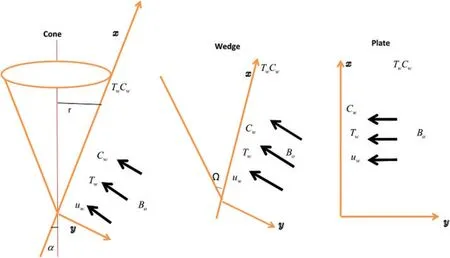
Figure 1:Schematic flow with coordinate system
The applied boundaries conditions are[48]

(1)Ifm=0 andα/=0 then flow problem for wedge.
(2)Ifm=1 andα/=0 then flow problem for cone.
(3)Ifm=0 andα=0 then flow problem for plate.
Introduced the suitable similarities variables

Transformation equations are as follows:
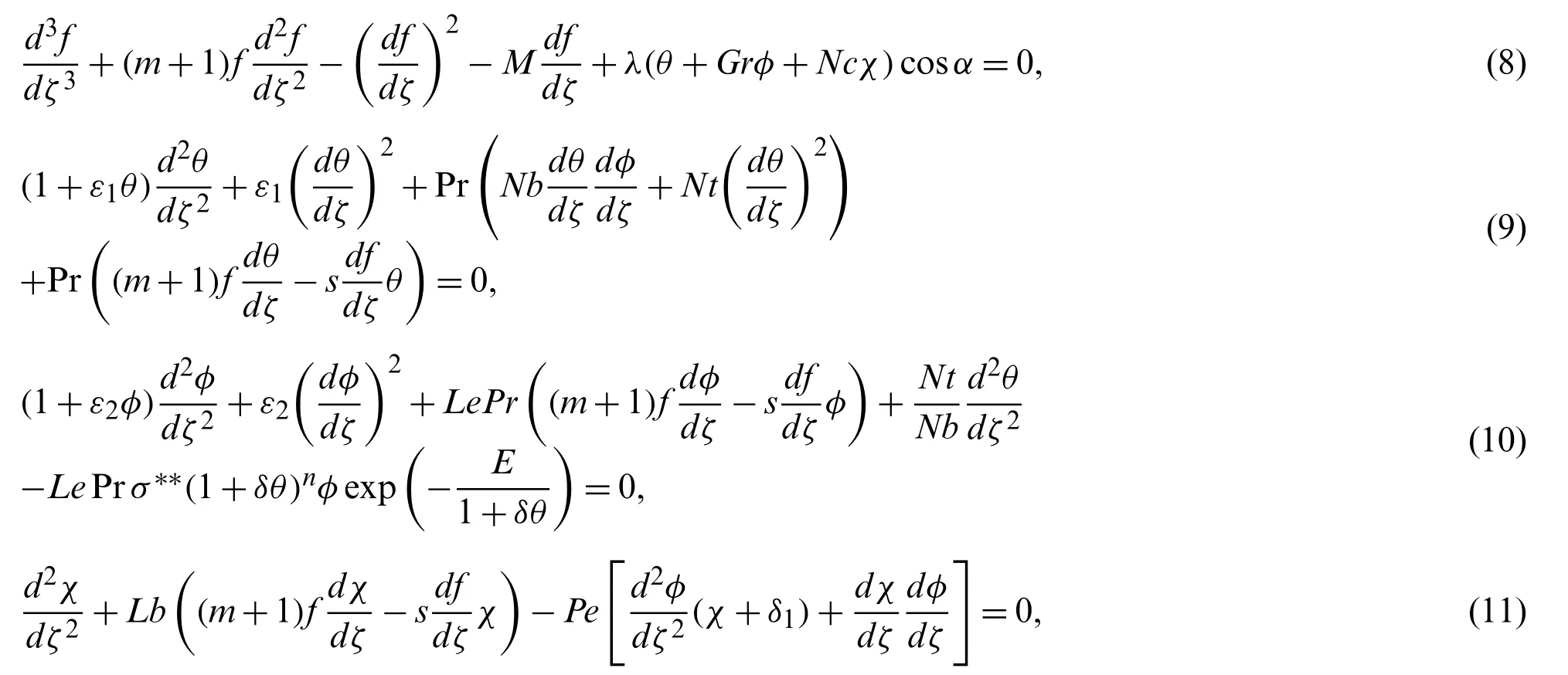
wheresrepresenting the temperature parameter.
The dimension-less conditions are as follows:

In above equationsMis the magnetic field,lis the characteristic length,λis mixed convection parameter,Grdesigned for Grashof number for concentration,Ncdescribe the Grashof number for microorganisms,Prexplain the Prandtl number,Nbdemonstrate the Brownian motion,Ntillustrate the thermophoresis diffusion parameter,Lbconfirm the bioconvection Lewis number,Perepresent the Peclet number,δis the temperature difference parameter,microorganisms difference parameter denoted byδ1and thermal Biot number characterized byΩ1,solutal Biot number indicated byΩ2and the microorganisms Biot number symbolized byΩ3,ε1is the temperature dependent thermal conductivity,ε2denotes the Concentration diffusivity,σ**denotes the chemical reaction parameter and melting parameter can be defined asMe.

The friction factorCf,local Nusselt numberNu,local Sherwood numberShandSndefined as

3 Numerical Scheme
In this portion the nonlinear dimensionless ordinary differential equations with appropriate boundary conditions are solved numerically through the solver bvp4c package in computational MATLAB.The higher order ODEs are converted into linear one by introducing the following variables such as
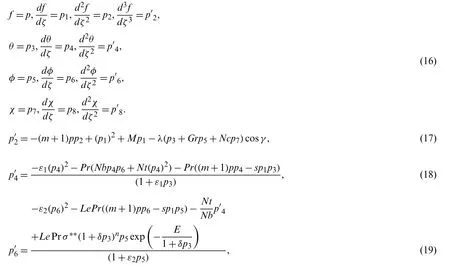

4 Description of the Results
In this section all the results of graphs are embellished and created by using the computational software MATLAB–16a(bvp4c)solver.For the understanding of figures,we must have to know about the color of curves demonstrated.The black curve demonstrates for wedge,red for cone and blue for sheet.The iterations of effective goods parameters increased or decreased with their individual behaviors.In this segment the graphic outcome interoperate for the different values of different parameters,like Pr=2.0,Pe=0.1,E=0.1,ε2=0.1,Lb=1.2,Le=1.2,Nb=0.1,Nt=0.1,Ω1=0.1,Ω2=0.2,Ω3=0.1,M=0.5,Nr=0.1,Nc=0.1,Me=0.5.
The influence of buoyancy ratio parameterNrand velocity distributionf′is illustrated in Fig.2.It is noticed from this figure that for the highest values ofNr,f′decreases(Fig.3).Illustrates the fluctuation of the bioconvection Rayleigh numberNcwith respect to the microorganism field with in the velocity profilef′.Such that the value of bioconvection Rayleigh numberNcincrease due to the increased value of microorganism graph.The relationship between the buoyancy and viscosity is known as Rayleigh number within the fluids.The significant magnetic field parameterMagainst velocity distributionf′has been examined in Fig.4.The velocity of the fluid decreased with the increased value ofM.Once more this behavior is defined as the Hartmann number is interlinked with the occurrence of Lorentz force.Figs.5–8 are examines the variation ofMeon motile density profileχ,concentration profileφ,temperature profileθand velocity profilef′respectively for three different geometries(wedge,cone and sheet).The fluctuation inMereduces the motile density profileχ,concentration profileφ,temperature profileθand velocity profilef′.

Figure 2:Pictogram of Nr over f′
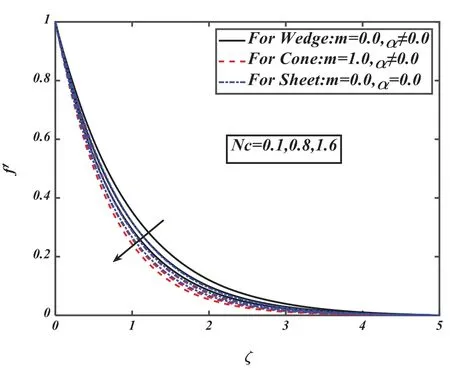
Figure 3:Pictogram of Nc over f′
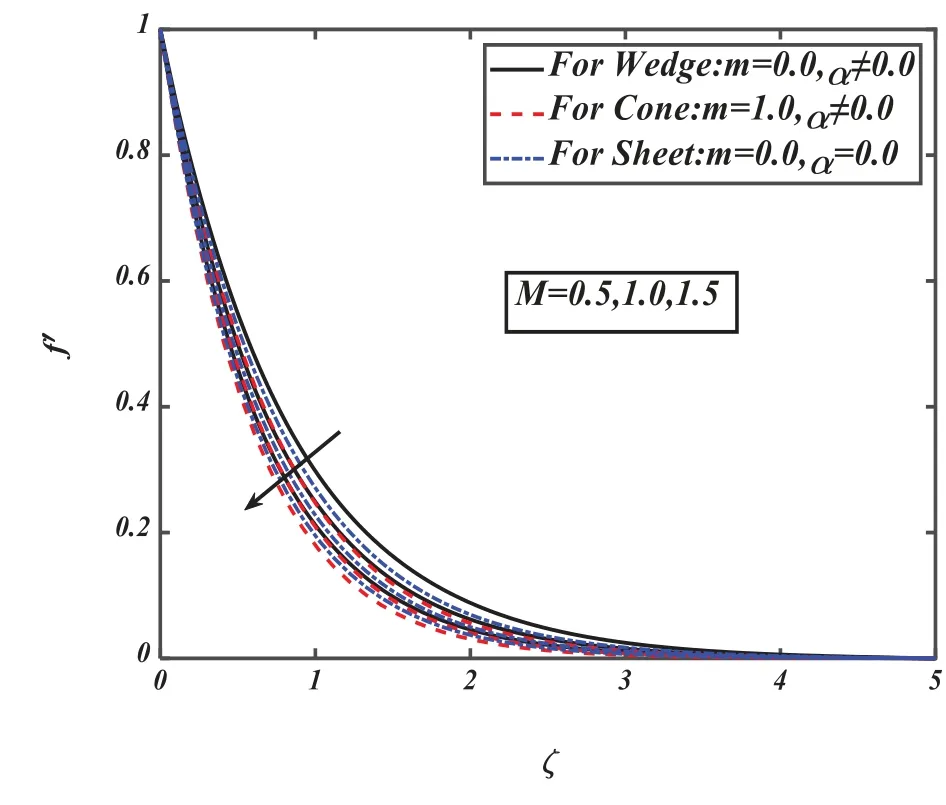
Figure 4:Pictogram of M over f′
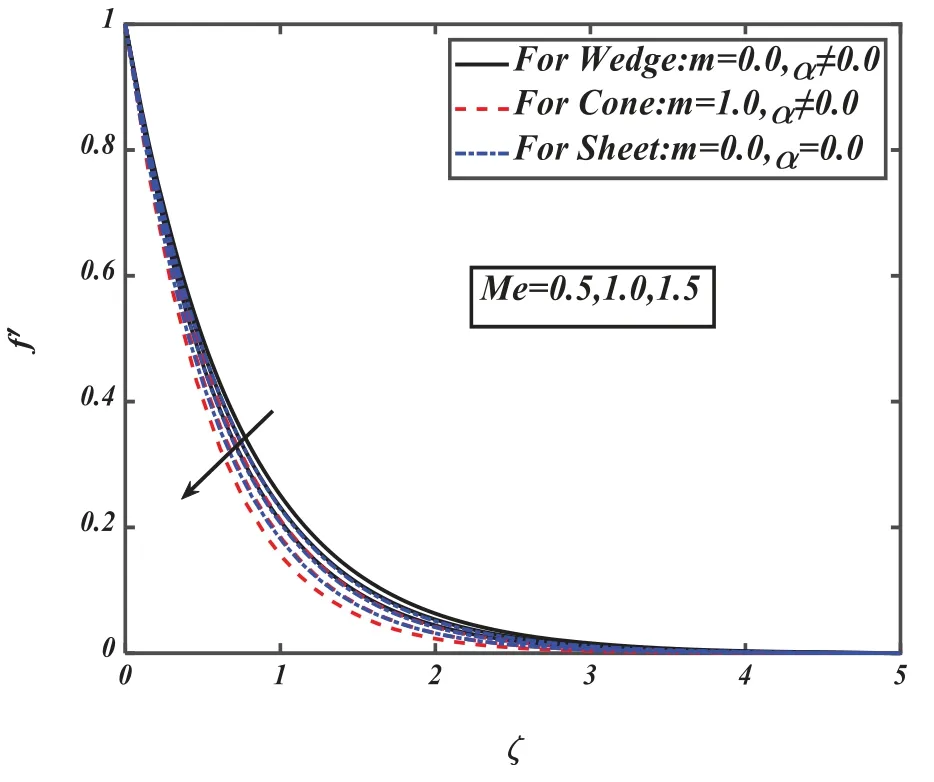
Figure 5:Pictogram of Me over f′
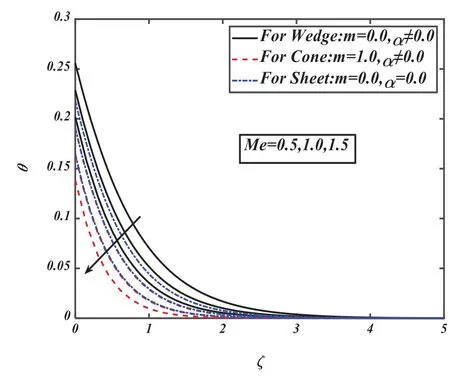
Figure 6:Pictogram of Me over θ
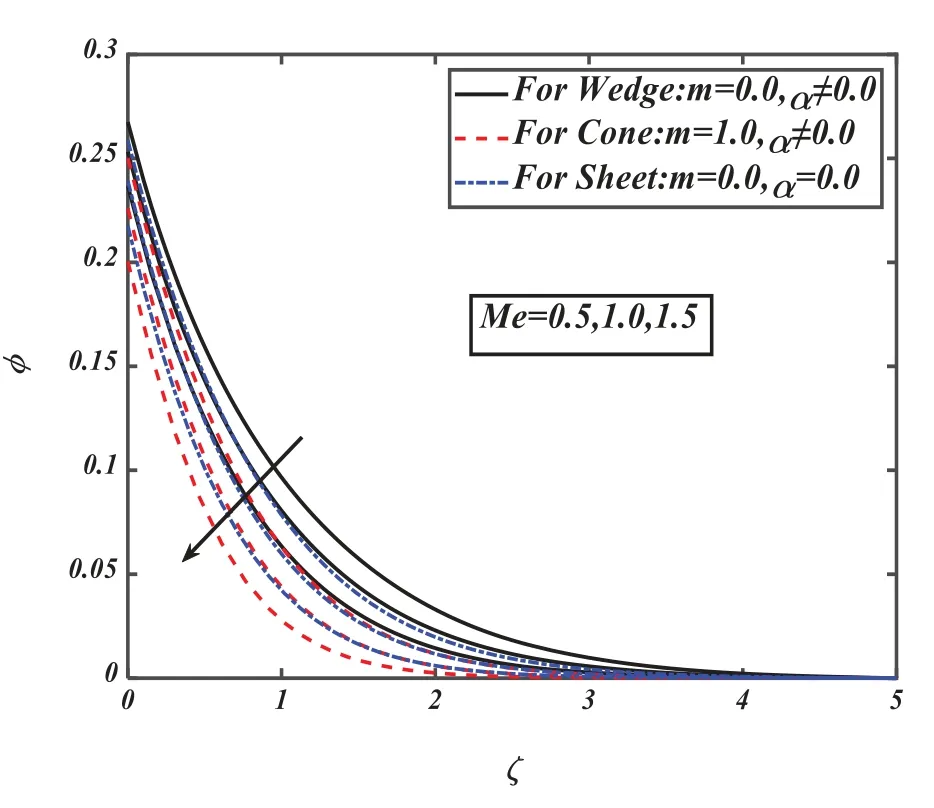
Figure 7:Pictogram of Me over φ
Fig.9 illustrates the impact of the Prandtl number over temperature distribution respectively for different value ofmfor cone,wedge and sheet.Fig.10 demonstrates the impact of thermal Biot number via temperature distribution for different geometries for several values ofmandα.For conem=1.0 and for other two geometries its zero.Fig.11 depicts that concentration is reduced via larger Prandtl numberPr.In Fig.12 the activation energyEparameter is communicated for the nanoparticles volume distribution.In this graph when the value ofEis increasing then the rate of reaction is decline due to higher temperature and greatest activation energy which develop the nanoparticles volume fraction.The concentration profile forε2is deeply observed in the Fig.13.Concentration dependent thermal diffusivity enhances the concentration field of nanoparticles.Fig.14 analyzed the effect of Lewis numberLeover concentrationφ.The decreasing inφis noticed for demonstrative value ofLefor three different geometries.TheLeis defined to be the ratio of mass and thermal diffusivity.Theφis decreased for the higher value ofLein these geometries.Fig.15 represented the variation ofφfor the Brownian motion parameter Nb.The relationship between Nb and nanoparticles concentration is inverse.φ.From Fig.16 the temperature distribution is upswing owing to the growing value of thermophoresis parameterNt.ForNtthe temperature profile improved,so the migration of particles from region to region exists as hot to cold region.Multi industrial processes use this concept now a days.The profile of concentration is increased for given value ofNt.The components of representational non–dimensional nanoparticles concentrationφis purposed through allotting unique values toNtfor three different geometries.
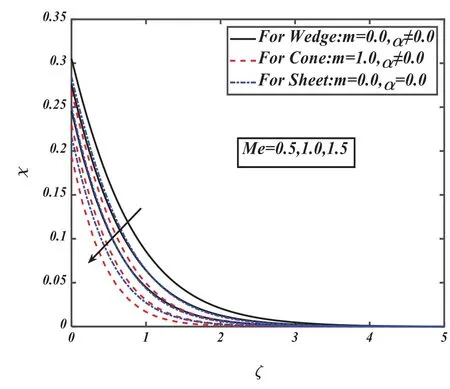
Figure 8:Pictogram of Me over χ
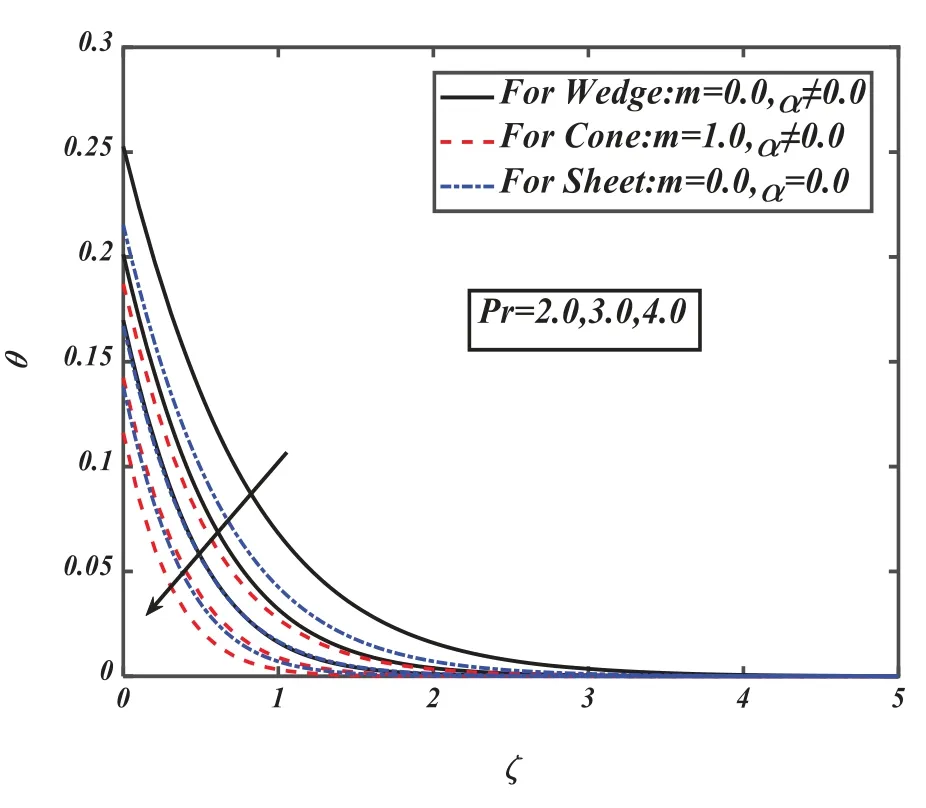
Figure 9:Pictogram of Pr over θ
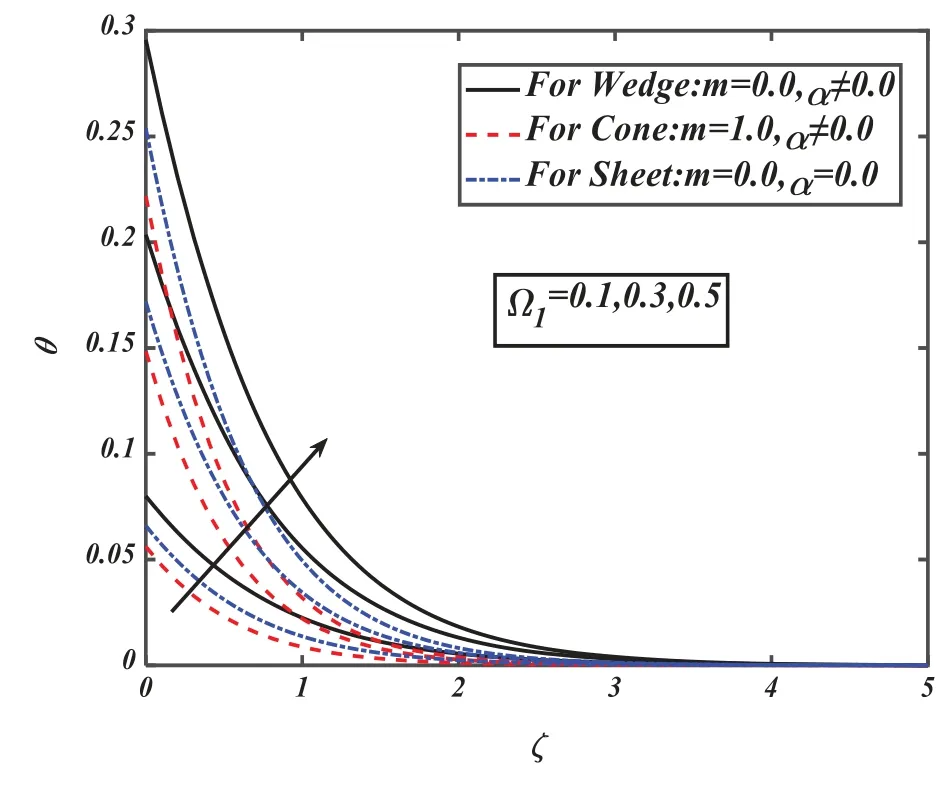
Figure 10:Pictogram of Ω1 over θ
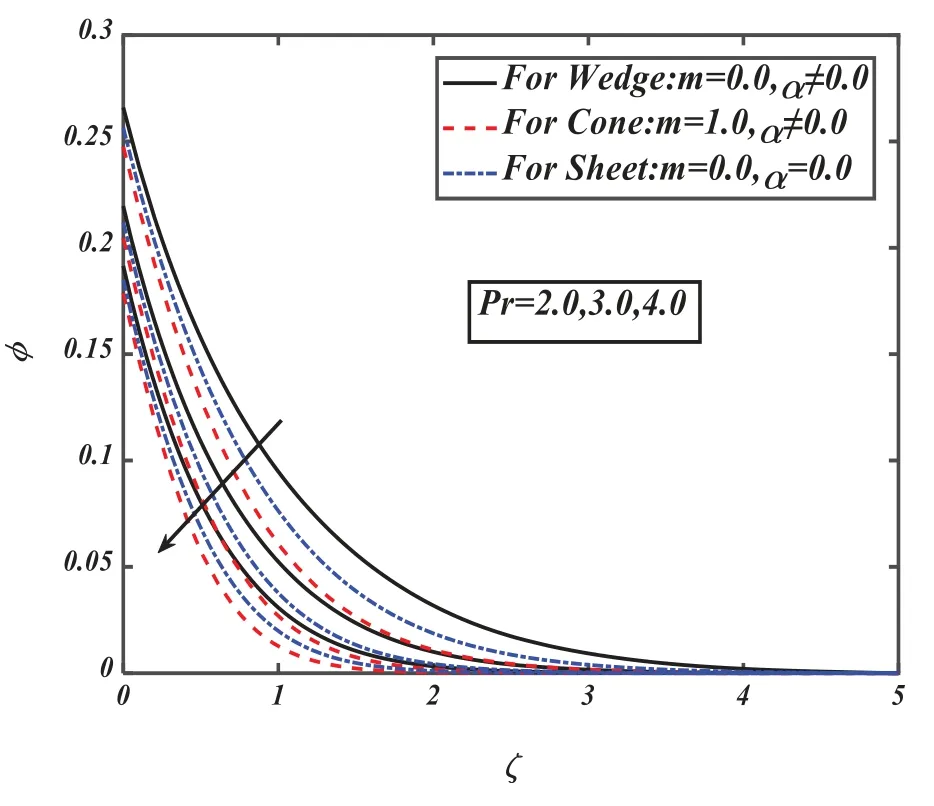
Figure 11:Pictogram of Pr over φ
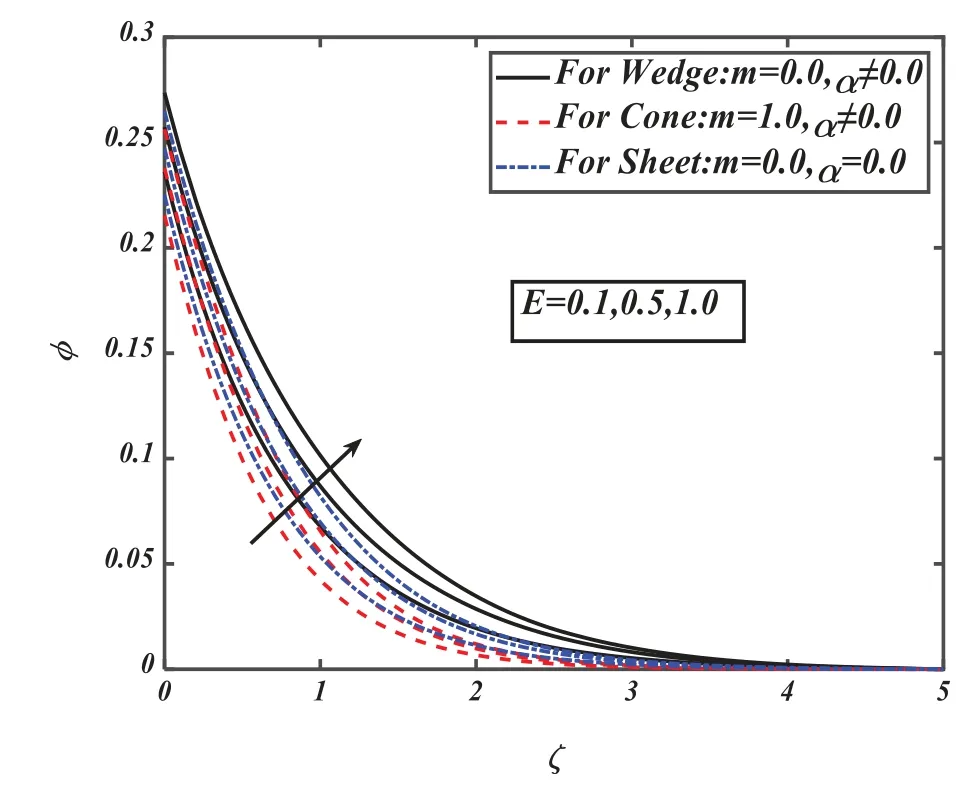
Figure 12:Pictogram of E over φ
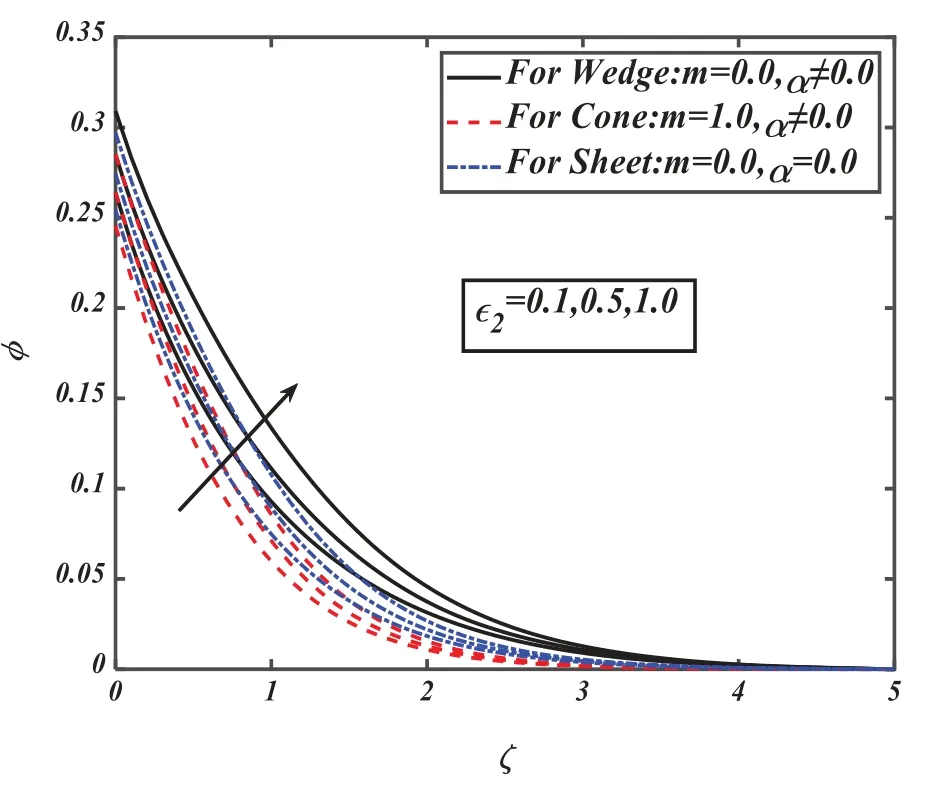
Figure 13:Pictogram of ε2 over φ
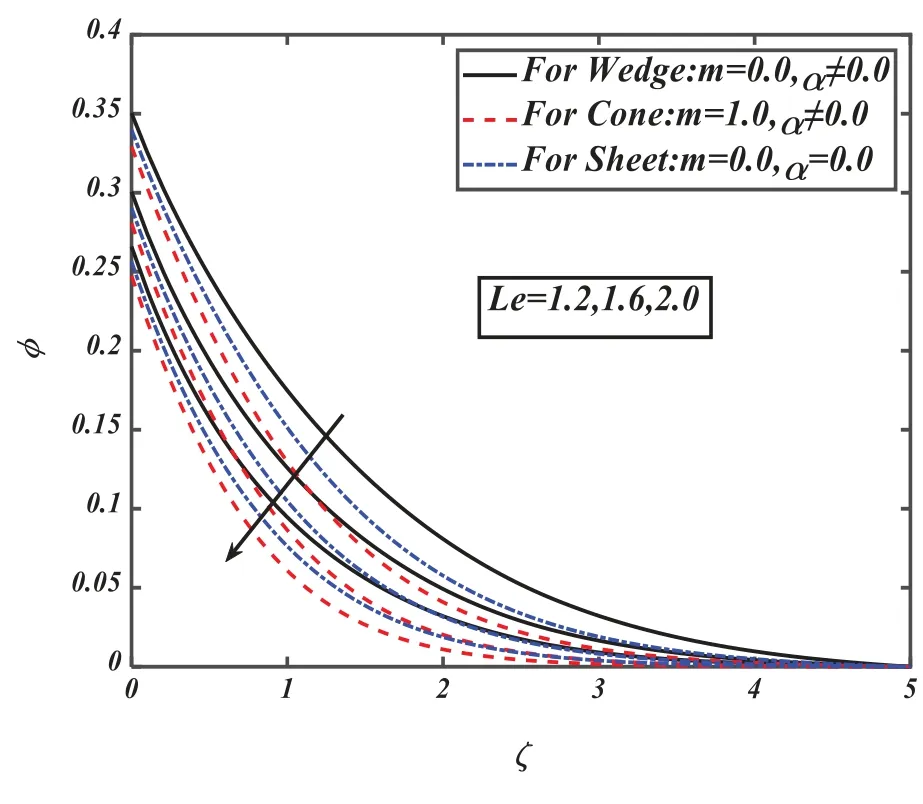
Figure 14:Pictogram of Le over φ
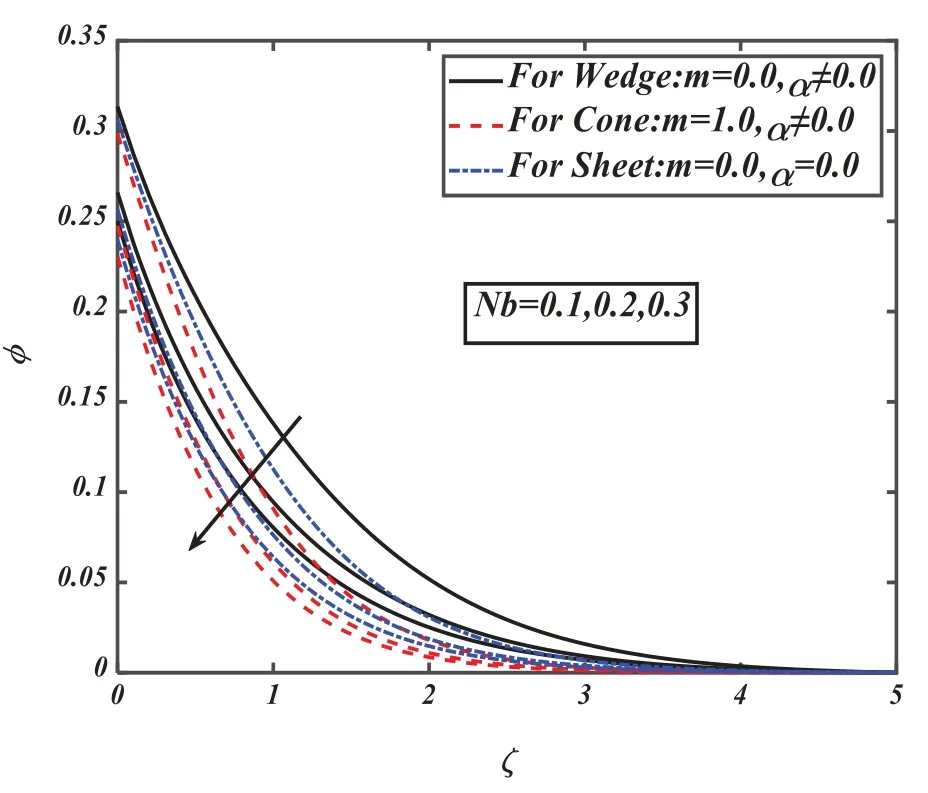
Figure 15:Pictogram of Nb over φ
Figs.17 and 18 explain the variation of solutal Biot numberΩ2,and microorganism Biot numbersΩ3respectively for concentration and motile density profiles.The concentration and motile density profile depends upon the Biot number for all three conditions with respect to all three different geometries(wedge,cone and sheet).Here concentration and microorganism’s field boosted for larger Biot numbers.Fig.19 illustrates the impact of Peclet number onχfor three different geometries like wedge,cone and sheet.Largest values of Peclet number diminish the microorganism distribution.Fig.20 illustrates that the bioconvection Lewis numberLbis a decreasing function for motile density profileχof three geometries(wedge,cone and sheet).Theχdiminished and the value ofLbare higher for the cause of increase in the diffusivity of the motile microorganism.
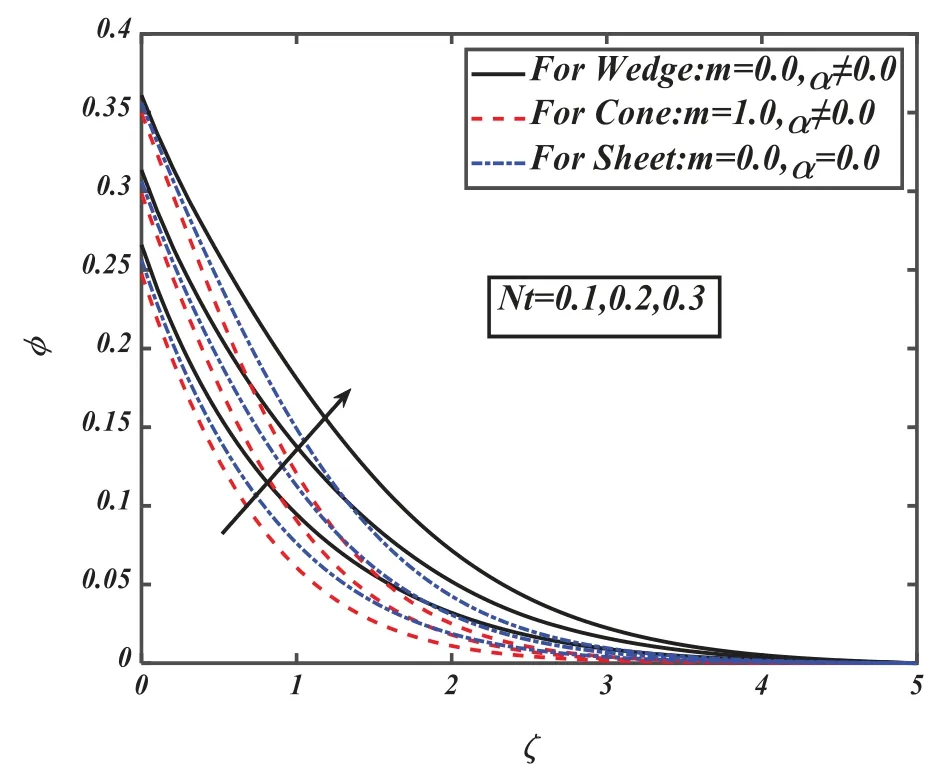
Figure 16:Pictogram of Nt over φ
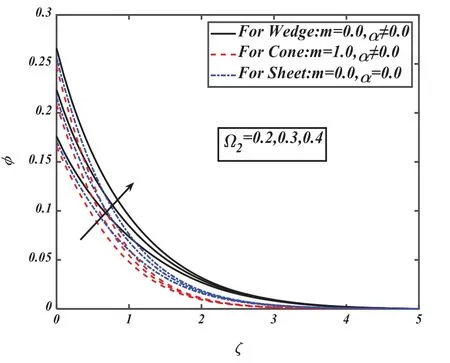
Figure 17:Pictogram of Ω2 over φ
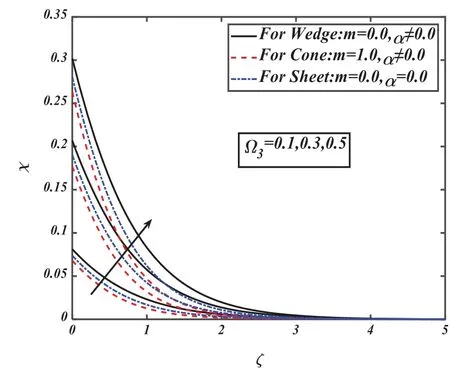
Figure 18:Pictogram of Ω3 over χ
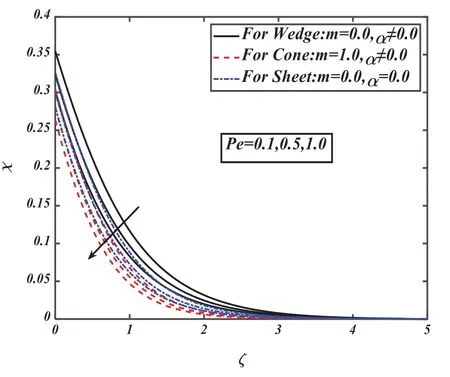
Figure 19:Pictogram of Pe over χ
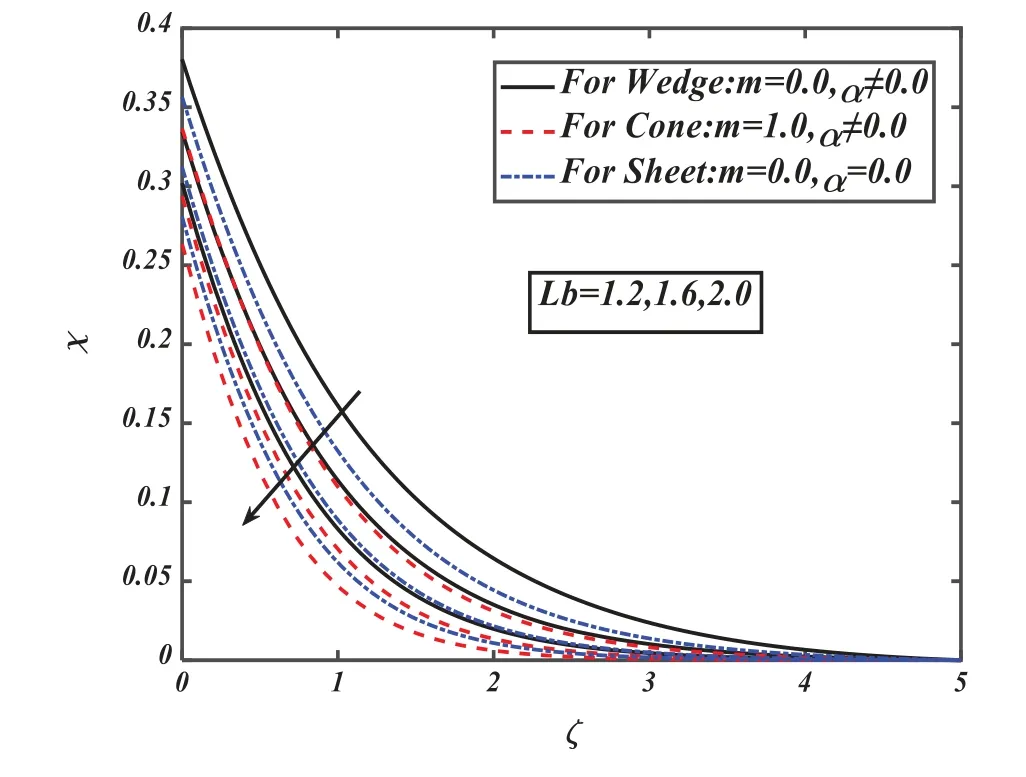
Figure 20:Pictogram of Lb over χ
5 Final Remarks
Heat and mass transformation of the nanofluid bioconvection flow under the melting mechanisms is scrutinized in the existence of cross-diffusion impacts.Mathematical modeling is fixed to scrutinize the flowing performance on vertically three different geometries(cone,wedge,and plate).Some significant remarks are synopsized below:
·Fluid exposure,the fluid velocity is highest for the flow over the plate as compared with the other two geometries(cone and wedge).
·The transformation rate of mass and heat is much better for the flow via cone than flow over the wedge.
·It is investigated that both the Brownian motion diffusion parameter and thermophoretic diffusion parameter are directly proportional to the temperature of the fluid.At the same time,concentration is directly proportional to the thermophoretic parameter but inversely proportional to the Brownian diffusion parameter.
·The temperature and concentration profile performance increased for the highest value in the thermophoretic parameter.
·The microorganisms’ density is inversely proportional to the Peclet number and Lewis number.
·This study analyzed the flow characteristics of non-Newtonian fluids extended for the present mathematical model.
·Reducing the amount of melting enhanced the heat transfer rate and velocity of the fluid.
Funding Statement:This work is financially supported by the Government College University,Faisalabad and Higher Education Commission,Pakistan.
Conflicts of Interest:The authors declare that they have no conflicts of interest to report regarding the present study.
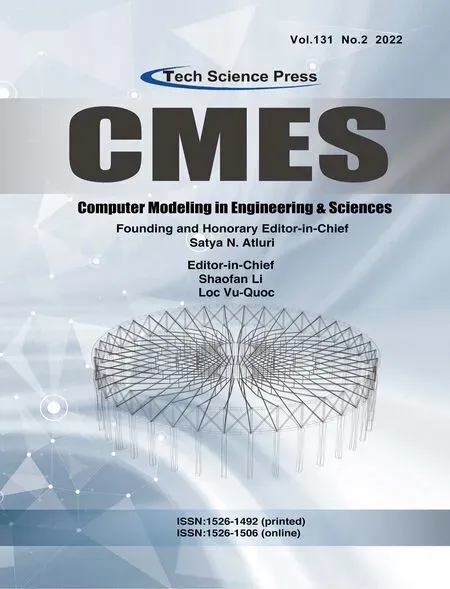 Computer Modeling In Engineering&Sciences2022年5期
Computer Modeling In Engineering&Sciences2022年5期
- Computer Modeling In Engineering&Sciences的其它文章
- Computational Investigation of Cell Migration Behavior in a Confluent Epithelial Monolayer
- The Hidden-Layers Topology Analysis of Deep Learning Models in Survey for Forecasting and Generation of the Wind Power and Photovoltaic Energy
- Conceptual Design Process for LEO Satellite Constellations Based on System Engineering Disciplines
- Deep Learning-Based Automatic Detection and Evaluation on Concrete Surface Bugholes
- Efficient Numerical Scheme for the Solution of HIV Infection CD4+T-Cells Using Haar Wavelet Technique
- Prototypical Network Based on Manhattan Distance
